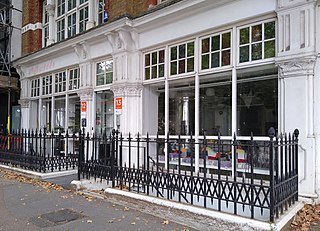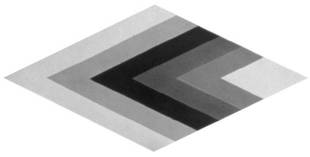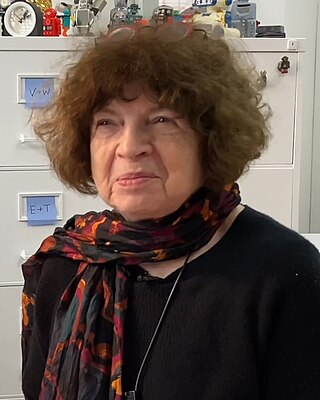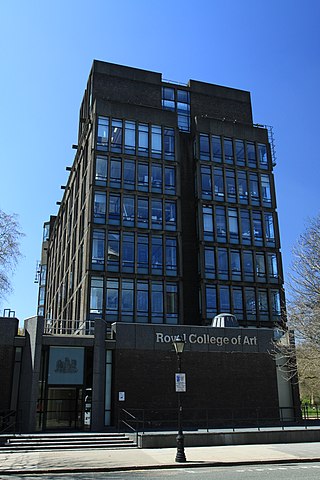Computer art is art in which computers play a role in the production or display of the artwork. Such art can be an image, sound, animation, video, CD-ROM, DVD-ROM, video game, website, algorithm, performance or gallery installation. Many traditional disciplines are now integrating digital technologies and, as a result, the lines between traditional works of art and new media works created using computers has been blurred. For instance, an artist may combine traditional painting with algorithm art and other digital techniques. As a result, defining computer art by its end product can thus be difficult. Computer art is bound to change over time since changes in technology and software directly affect what is possible.

Electronic art is a form of art that makes use of electronic media. More broadly, it refers to technology and/or electronic media. It is related to information art, new media art, video art, digital art, interactive art, internet art, and electronic music. It is considered an outgrowth of conceptual art and systems art.

Frieder Nake is a mathematician, computer scientist, and pioneer of computer art. He is best known internationally for his contributions to the earliest manifestations of computer art, a field of computing that made its first public appearances with three small exhibitions in 1965.
Robert John Lansdown was a British computer graphics pioneer, polymath and Professor Emeritus at Middlesex University Lansdown Centre for Electronic Arts, which was renamed in his honour in 2000.
The Lansdown Centre for Electronic Arts was a research centre at Middlesex University in North London, England. It played a significant role in the early development of computer graphics and continued to innovate in interactive media, sonic arts and moving image. It also provided postgraduate and undergraduate teaching.

Brian Reffin Smith is an artist, writer, teacher and musician born in Sudbury, Suffolk, in the United Kingdom, who won the first-ever Prix Ars Electronica, the Golden Nica, in Linz, Austria, 1987. He lives in Berlin, Germany.
The Computer Arts Society (CAS) was founded in 1968, in order to encourage the creative use of computers in the arts.
Edward Ihnatowicz was a Polish cybernetic art sculptor active in the late 1960s and early 1970s. His sculptures explored the interaction between his robotic works and the audience.

System Simulation Ltd (SSL) is a software engineering company now specialising in text and multimedia information systems, based in Clerkenwell, central London, England, and founded in 1970 by George Mallen.
Charlie Gere is a British academic who is professor of media theory and history at The Lancaster Institute for the Contemporary Arts, The University of Lancaster and previously, director of research at the Institute for Cultural Research at The University of Lancaster. He is author of several books and articles on new media art, art and technology, continental philosophy and technology. His main research interest is in the cultural effects and meanings of technology and media, particularly in relation to post-conceptual art and philosophy.

Systems art is art influenced by cybernetics and systems theory, reflecting on natural systems, social systems, and the social signs of the art world itself.
Cybernetic Serendipity was an exhibition of cybernetic art curated by Jasia Reichardt, shown at the Institute of Contemporary Arts, London, England, from 2 August to 20 October 1968, and then toured across the United States. Two stops in the United States were the Corcoran Annex, Washington, D.C., from 16 July to 31 August 1969, and the newly opened Exploratorium in San Francisco, from 1 November to 18 December 1969.

Jasia Reichardt is a British art critic, curator, art gallery director, teacher and prolific writer, specialist in the emergence of computer art. In 1968 she was curator of the landmark Cybernetic Serendipity exhibition at London's Institute of Contemporary Arts. She is generally known for her work on experimental art. After the deaths of Franciszka and Stefan Themerson she catalogued their archive and looks after their legacy.

Cybernetics is the transdisciplinary study of circular processes such as feedback systems where outputs are also inputs. It is concerned with general principles that are relevant across multiple contexts, including in ecological, technological, biological, cognitive and social systems and also in practical activities such as designing, learning, and managing.

Doron Swade MBE, born 1944, is a museum curator and author, specialising in the history of computing. He is especially known for his work on the computer pioneer Charles Babbage and his Difference Engine.

Cybernetic art is contemporary art that builds upon the legacy of cybernetics, where feedback involved in the work takes precedence over traditional aesthetic and material concerns. The relationship between cybernetics and art can be summarised in three ways: cybernetics can be used to study art, to create works of art or may itself be regarded as an art form in its own right.

Event One was an early digital art exhibition held at the Royal College of Art (RCA), London, England, in 1969.

White Heat Cold Logic (2008), edited by Paul Brown, Charlie Gere, Nicholas Lambert, and Catherine Mason, is a book about the history of British computer art during 1960–1980.

George L. Mallen FBCS FRSA is a British businessman who has been a pioneer of creative computer systems since 1962. He co-founded the Computer Arts Society (CAS) with Alan Sutcliffe and John Lansdown in 1968. In 1970, he led CAS members in creating Ecogame, the "first digitally driven, multi-player, interactive gaming system in the UK". Also in 1970, he founded the company System Simulation Ltd, one of the longest established software companies in the United Kingdom.
Paul Brown is an artist with an interest in the combination of art and technology, who has been based in England and Australia.












